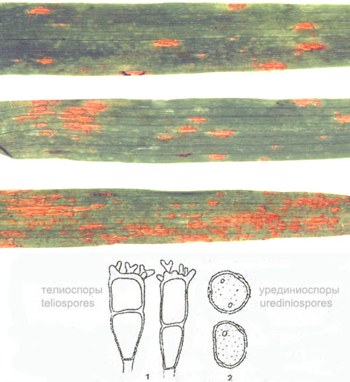Diseases
Puccinia coronata Corda - Crown Rust of Oats.
Systematic position.
Class Basidiomycetes, subclass Teliosporomycetidae, order Uredinales, family Pucciniaceae, genus Puccinia.Biological group.
Biotroph.Morphology and biology.
Puccinia coronata is a heteroecious, macrocyclic, obligate parasitic fungus. Stages 0-I develop on Rhumnus spp., and Frangula spp., II-III on species of Avena, Bromus and others Poaceae. Crown Rust of Oats is present as small, oval orange-yellow pustules containing urediniospores. The pustules are found on both surfaces of leaves, sometimes on leaf sheaths and stems. Urediniospores are spheric, ellipsoidal, with small number of thorns, having from 3-4 to 10 pores. The telia are located on the lower side of leaves, sometimes around uredia, and are black, shiny. Teliospores are clavate, with processes of different size and shape (like a crown). Telia overwinter; in spring the teliospores germinate and produce haploid basidiospores, which infect the alternative host, forming spermogonia. The spermacia copulate and a new diploid generation form aecias on the lower side of alternative host leaves. The aeciospores infect oats or other gramineous hosts, forming uredia and starting a new uredinial stage (Ishkova et al., 2002).Distribution.
Occurs everywhere in Europe, Asia, America, and Australia where there is oat cultivation. In Russia it is found in the whole region where oats are cultivated (Transhel, 1939; Ishkova et al., 2002).Ecology.
With correct climate temperatures the disease appears usually on oats at the heading stage. Urediniospores germinate and penetrate at 10-40 .C (optimal temperature is 20-25.C) with the presence of condensed moisture (dew). Under favorable conditions an uredogeneration develops for 6-7 days, so the development of several generations is possible during a season (Dmitriev, 2000). The urediniospores disseminate by wind for a short or long (hundreds km) distance. The disease winters in teliostage. In tropical and subtropical zones the wintering by urediniospores is possible (Dmitriev, 2000).Economic significance.
Crown Rust is one of the most destructive of all oat diseases. The infection results in reduced yields, lowers test weights, and increases pelliculation. Yield losses amount to 10-20% and more during epiphytotic conditions (Dmitriev, 2000). Early disease infestation during favorable weather conditions may completely eliminate grain yield. Control measures include the use of resistant and early maturing varieties, chemical and biological fungicides.Reference citations.
Dmitriev A.P. 2000. Oats rusts. Saint Petersburg: VIZR. 111 p. (In Russian)Ishkova T.I., Berestetskaya L.I., Gasich E.L., Levitin M.M., Vlasov L.Iu. 2002. Diagnostics of the main fungus diseases of cereal crops. Saint Petersburg: VIZR. 76 p. (In Russian)
Transhel V.G. 1939. Review of rust fungi of the USSR. Moscow-Leningrad: Nauka. 426 p. (In Russian)
© Dmitriev A.P.


